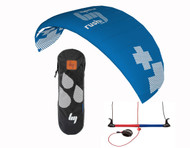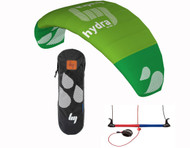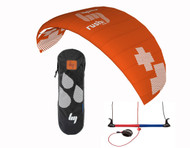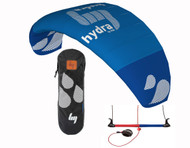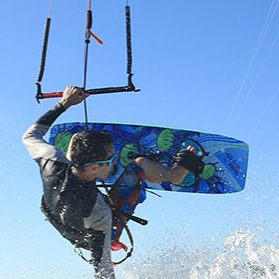
I'm new! I'm looking for a trainer kite...
I'm looking for a beginner, entry-level power kite for...
I'm looking for a board...
- Home
- Trainer Kites
- LEARNING CENTER
- Trainer Kite FAQs
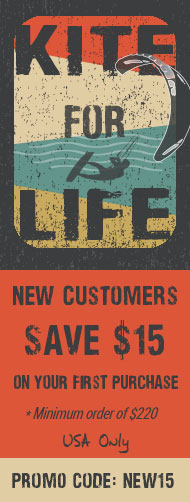
Categories
Shop by Price
Brands
Current Top Sellers
-
$279.00

-
$389.99$379.99
-
$349.99

-
$439.99$435.45
-
$348.50$345.50
Trainer Kite FAQs
Check out our Trainer Kite Reviews to compare individual trainer kites.
Most Common Questions About Trainer Kites
Scroll down to read the most common questions we are asked about trainer kites and beginning your kiteboarding, landboarding, or snow-kiting adventure.
Why Do I Need a Trainer Kite?
A Trainer Kite is a Safer Way to Learn!
 YES, Think about it.... Would you teach your teenager to drive a car with a 5-speed on steep hills in heavy traffic? We hope not.
YES, Think about it.... Would you teach your teenager to drive a car with a 5-speed on steep hills in heavy traffic? We hope not.
Wouldn't it be safer and smarter to learn how to drive a 5-speed in a parking lot, early on a Sunday morning "before" venturing out into more demanding conditions? Heck yeah.
When learning how to kiteboard it is all about learning kite control and how a kite will respond to your input. Learning to master good kite flying skills begins with learning to safely pilot a trainer kite.
With a good Instructional DVD you can learn different ways to launch and land your kite, the different positions in the wind window, how to accelerate or reduce the power a kite will produce by flying the kite in different patterns, and how to park your kite in the different neutral zones along the edge of the wind window. This important step to learning how to kiteboard is learning kite control.
A trainer kite is a safer way to learn basic flying skills before venturing out to a larger kite.
A Trainer Kite is a Smart Investment!
Save money by practicing with a trainer kite before taking lessons. This will shorten your lesson time considerably, plus give you valuable experience so you have a good knowledgebase to build on.
No doubt that you'll be better prepared and learn far more during your lesson, having mastered kite flying basics beforehand.
What's the Best Trainer Kite?
 As far as which trainer is the "Best of the Best", there is NO #1 best trainer kite is the same for everyone.
As far as which trainer is the "Best of the Best", there is NO #1 best trainer kite is the same for everyone.
A better question to ask is... Which is the best trainer kite FOR YOU?
Top 3 Trainer Kites
The current top selling trainer-kites are all of the 3-line models:
- Scout III 3m / Scout III 4m. Excellent for learning traction sports and snowkiteing
- Rush V Pro 300 / Rush V Pro 350. Great for all kiting sports and practicing on land
- Hydra II 300 / Hydra II 350. Fantastic for practicing on land and water.
How Does a Trainer Kite Compare to a Full-Size Kite?
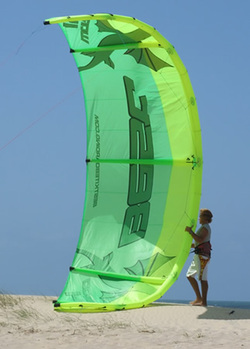 Trainer kites are much smaller than full-size kites. The purpose is to learn to handle a smaller kite before you advance to a larger kite.
Trainer kites are much smaller than full-size kites. The purpose is to learn to handle a smaller kite before you advance to a larger kite.
As you can imagine, the consequences of making common beginner errors on a small trainer kite is very different than making the same errors on a much larger, more powerful kite. We highly recommend learning on a trainer kite before advancing to a full-size kite.
- Full-size kites range from 7m to 17m
- Popular full-size kite ranges from 9m to 13m
- 13m = 13 square meters
- The most popular size trainer kites are much smaller at only 2m to 3.5m
3.5m Trainer Kite vs a 13m Inflatable Full-Size Kite, which is 4 times the size! - That's a HUGE difference in power!
Will I Still Want My Trainer After I Purchase a Full Size Kite?
The short answer is Yes!!
Trainer kites are great for learning, but also fun for those who don't have the set-up time for a full-size kite. Most of our customers still use their trainer kites for recreational use even after purchasing a full-size kite.
How Much Set-up Time Does it Take?
Due to time constraints, you'll be using the trainer kite more often than you imagine. On your busy days, when you don't have the needed 2+ hours of free time to ride on the water, you will likely be able to find 30-45 minutes to fly your trainer.
Time to Set Up a Trainer Kite
30 Minutes: Average time needed to have fun with your trainer kite while logging in valuable practice time and sharpening your kite skills. You can hit the local park on your lunch break or after work, and stay in your regular clothes.
Time to Set Up a Full-Size Kite
2 Hours or more is the average time needed to enjoy 30 mins to 1 hour of full-size kiting on the water. Driving to the beach, changing clothes, rigging your kite, riding, then de-rigging, driving home, showering... it all takes time.
If you can't get at least 1 hour in the water, most people don't bother.
Demo / Used / Pre-owned Trainers?
Thousands of trainer kites are sold each year, so do you ever wonder why it's so difficult to find a used trainer kite for sale? It's because people want to keep them!
It makes sense: Low cost, high value, and the ability to continue sharpening your skills. Plus, trainer kites are fun to share recreationally with friends and family.
Yes, on occasion we'll have a demo kite for sale and list it on our Specials page.
FREE Instructional DVD or Wind Meter
 To help you be successful, with each purchase of a trainer kite we include the option for a free Instructional DVD or a Windmeter (Anemometer).
To help you be successful, with each purchase of a trainer kite we include the option for a free Instructional DVD or a Windmeter (Anemometer).
If you're new to kiting, we feel that a good DVD is important. Or, if you're not interested in a DVD, we offer a windmeter. Our favorite windmeters are the mechanical type. They're very durable and outlast the the overpriced digital models.
DVD or windmeter, your choice!
** In recent years, we're seeing more and more excellent (and free) videos being posted on youtube. Yes.... we're happy to email you some links.
Our Windmeter
- Easy to use
- Durable
- Crazy accurate
Where Can I Fly My Trainer?
Your trainer kite can be flown in any wide-open area that allows the wind to flow mostly unobstructed.
Watch out for obstacles!
The less obstacles the wind needs to pass through, the "cleaner" /smoother it will be. When wind is forced to go over or around tall buildings, other obstacles or land features that block the wind, the wind becomes turbulent, shifty, gusty, and much more challenging for kite flying. However, it is good to experience how your kite responds in different environments and why it is important to learn safe flying conditions for a full size kite.
Neighborhood parks, football, baseball, and soccer fields "can" be good options for flying a trainer kite. Be sure to stay far away from power lines or "kite-eating-trees". It's true, trees love to eat kites! For sure, the ideal spot would be a wide sandy beach, followed by a large grassy field. We have one customer that learned in a straw field with 2 foot high shrubs. Ideal? No. Do-able? Yes!
Can I Use My Trainer Kite in the Water?
The fast, simple answer is NO. Almost all trainer kites are designed for practicing your kite skills on land and most trainer kites have an "open-cell ram-air" design. Once the kite contacts the water, it stays in the water.
Almost all trainer kites are designed for practicing your kite skills on land and most trainer kites have an "open-cell ram-air" design. Once the kite contacts the water, it stays in the water.
The other answer is YES... IF it's an amphibious water relaunchable foil kite.
The HQ Hydra is exactly that; a trainer that can be used on land or on the water. Thus, the reason we call it a amphibious trainer. Specific details are on the Hydra Page.
Being Realistic. Although the Hydra "can" be used in the water, it's still only a trainer kite and doesn't have enough power for the real kiteboarding experience you see at the beach or on video. Kiteboarders typically use much larger 9m to 12m kites. However, the Hydra can easy pull someone on a kayak or on an SUP (Stand-Up Paddle Board).
How Much Wind Do I Need to Fly My Trainer Kite?
Short Answer: 7 mph or above.
As a beginner, the 7-14 wind range is a good place to start.
I would say 7 mph is a bare minimum if the wind is steady. That number will vary depending on your local conditions.
If the wind is gusty, the wind may be 8 mph, but lulls down to 4 mph which is not enough wind to fly with. 10-15 is more fun than a marginal 7-8.
You "can" fly your kite in less wind, but lighter winds requires more skill since you'll need to "generate" the extra power by the way you move the kite across the sky.
Stronger winds of 15-20 mph are fun AFTER gaining some experience and confidence flying your kite in lighter winds. IF your kite has difficulty launching, or staying in the air, it's most like due to not having sufficient wind, or the wind being blocked by houses and trees.
Can I Fly the Trainer Kite on My Own or Do I Need an Assistant?
Only 1 person is needed for 3-line trainer kites.
Just you! That said, having another person to assist is nice and makes learning more fun. The 3-line kites do allow you to easily "reverse re-launch" your kite by yourself using the 3rd-line.
Control Bar or Handles?
 If your goal is simplicity, safety, functionality, and fun, and your intention is to progress to any of the kiteboard sports, we recommend using a control bar.
If your goal is simplicity, safety, functionality, and fun, and your intention is to progress to any of the kiteboard sports, we recommend using a control bar.
The 3-line control bars are standard with our trainer kites.
Control bars come pre-configured from the manufacturer with an integrated 3rd line safety system.
Since we specialize in kiting sports, we mainly sell kites that are already set-up with control bars. If you're shopping here, we've got you covered.
Kite Terminology
"3m" denotes that the kite is 3 square meters
Most people just say "meter" when they are actually referring to square meters.
Trainer Kites
- Range from 1.5m to 3.5m, (Most are 2.5m to 3.5m).
- Can be a 2-line, 3-line, or 4-line and normally set-up with a control bar
Full-Size Kites
- Range from 7m to 17m.
- Can be a 3-line, 4-line, or 5-line and DO NOT come with a control bar.
True Size or Just a Name?
The Name Doesn't Give the Actual Kite Size
When comparing kites, use the "true size" if you know it, rather than the model name. Many times the name of the kite is NOT the same as the actual kite size.
Examples: Rush V 300-Pro, Hydra II 300.
At first glance you would think that the two trainer kites mentioned above would be the same size and have about the same amount of power, right?
With HQ, the number represents the wing-span. 300 cms from tip to tip.
- Rush V Pro 300 True Size is (2.8m)
- Hydra II 300 True Size is (2.6m)
As you can see in this example, although both are named "300", their true sizes are different!
One of them is 2.8m, and the other is a smaller 2.6m
Which Size Trainer for Me?
Different Size Kites for Different Purposes
- Trainer Kites 1.5m to 3.5m: Small enough to use for learning
- Traction Kites 2.5m to larger: Powerful enough to provide a strong pull.
- Traction-Trainer 2.5m to 3.5m: A size that spans both categories; trainer and traction.
A 3.5m in 15 mph winds can give a 180 lb adult a workout! The very same 3.5m can be flown by a kid under 100 lbs in light 7-10 mph.
Body weight, wind-speed and skill level are all factors.
Traction-Kites 4m-5m range "can" be a trainer kite for big guys!
How Many Lines?
2-Line Trainer Kites
 Two Line Trainers like the "Rush V Standard Series" (200, 250, and 300) have the simplest design and are the lowest in price. If your budget is tight and you just want a basic trainer, a 2-line will do the job.
Two Line Trainers like the "Rush V Standard Series" (200, 250, and 300) have the simplest design and are the lowest in price. If your budget is tight and you just want a basic trainer, a 2-line will do the job.
Pros:
- Lowest Price
- Intuitive ultra-simple line set-up.
- 1 line on the Left, and 1 line Right
- Perfect for kids!
Cons: No "reverse relaunch"
4-Line Trainer Kites
Four line kites like the "Ozone Uno", have a fixed bridal, and thus a fixed angle-of-attack just like the 2-line, and 3-line kites. All of these "standard foils" are easy to fly.
The 3-line, and 4-line models fly mainly off the 2 front lines.
The additional 3rd and 4th line, allow you to reverse re-launch your kite, and also provides a way to stall the kite (kill its power) by releasing your control bar.
Four-line trainer kites most closely simulate a full size kite. They also require hooking into a harness (purchased separately), which adds an additional risk factor.
3-Line Trainer Kites
As far as trainer-kites go, the 3-line is currently the most popular design.
- 3-lines have an easy set-up close to a 2-line,
- They have the reverse re-launch abilities
- They have the back line safety / power kill ability.
Bottom line... we think the 3-line trainers are the best option for people shopping for their first kite.
Landboarding and Snow-Kiting
If you are planning to use your trainer to begin learning either of these sports, it's better to get a 3 or 4 line trainer, rather then a 2 line. Having the 3rd or 4th line will make it much easier to relaunch your kite while remaining with your board.
As a kiter and kite instructor for over 13 years, you can be sure that our recommendations are all about YOU in an effort to help you learn as quickly, safely, and as economically as possible.
Additional Savings / Lowest Price
Are you the kind of person who spends hours searching websites to save a few dollars?
" How Much!? ... Yeah.. we can beat that! " ™
If you happen to find a lower legitimate price let us know, and we'll beat it!
Even with the same price , you would still win big, because no one can compete with our level of customer service.
Read our testimonials.
On occasion, we have barely used Demo kite for sale. Be sure to check our Specials page.
 Loading... Please wait...
Loading... Please wait...



